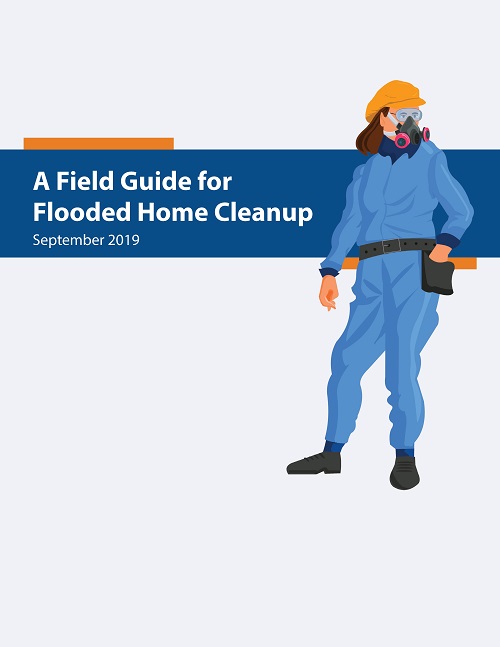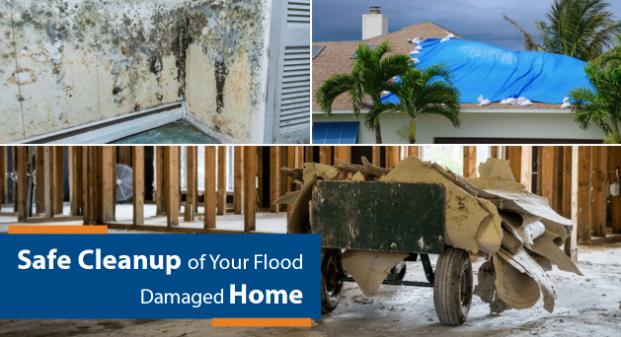Out Now: A Remade, Remodeled Flood Guide and Training Course from Enterprise and NCHH
Media Contact: Christopher Bloom, cbloom@nchh.org, 443.539.4154
(Columbia, MD, February 26, 2020) – A widely used guide, first developed nearly 15 years ago to teach safe mold removal practices in hurricane-damaged homes, has received a makeover courtesy of the National Center for Healthy Housing (NCHH), a highly respected national nonprofit, and Enterprise Community Partners, a leading national community development organization. In addition, NCHH has created a free online training course to educate homeowners and contractors in mold removal safety.

Revisions to A Field Guide for Flooded Home Cleanup and the creation of the new e-learning course, Safe Cleanup of Your Flood Damaged Home, were generously funded through a cooperative agreement between the Centers for Disease Control and Prevention’s (CDC) National Center for Environmental Health and the National Environmental Health Association (NEHA). The mold removal guide is available now in both English- and Spanish-language editions, and the training may be accessed via NCHH’s learning management platform.
Removing standing water and water-damaged materials within the first 48 hours are critically important steps toward preventing or limiting mold growth in flooded homes. Exposure to mold, including dead spores, can provoke allergic reactions, including asthma attacks, and other respiratory issues, such as eye irritation, runny nose, sneezing, and rashes. Young children and people with respiratory problems are especially vulnerable to the effect of mold exposure.
A Field Guide for Flooded Home Cleanup replaces Creating a Healthy Home, a collaboration between NCHH, Enterprise, and NeighborWorks America with Neighborhood Housing Services of New Orleans and funded by the Robert Wood Johnson Foundation in 2006. The Home Depot Foundation funded a second printing of the guide in June 2008 to aid families whose homes were overrun by the Mississippi River; this edition has been distributed and used in support of multiple disasters over the last decade.
The document honors the memory of Dennis Livingston, a revered Baltimore-based artist and urban activist who died in 2011. Mr. Livingston’s hand-drawn black-and-white sketches were a highlight of the original guide. The team used those as a foundation for new full-color vector graphics in the reimagined version.
Interactive Training

Accompanying the guide is a new e-learning course, Safe Cleanup of Your Flood Damaged Home, which educates users about the possible hazards in a home following a flood, the proper equipment needed to work safely in affected homes, and the importance of the prework inspection.
Much of the content found in both A Field Guide for Flooded Home Cleanup and Safe Cleanup of Your Flood Damaged Home originates in a protocol that was tested on four New Orleans homes in 2005-2006 following hurricanes Katrina and Rita; however, the team also replaced a few recommendations from the original guide with new techniques for successful mold removal. The recommendations from an expert technical advisory panel the team worked with in 2019 also played a significant role in the revision process.
“This guide has helped many communities since its original publication in 2006. As flooding events become more common, we know that many more communities will be looking for the most up-to-date advice,” said NCHH Executive Director Amanda Reddy. “Our team has pored over every word and detail of the new guide and the e-learning modules to ensure we’re presenting both the latest science and the safest practices in cleaning flooded homes. We’re extremely pleased with the results, and we look forward to sharing this guide and training course with those who need it most.”
NCHH recommends the following steps for cleaning homes after flooding:
- Mop or pump out any standing water and dry out the building as soon as possible. Open doors and windows.
- Cleaning and disinfection are two separate processes. Use a mild detergent and water to clean and remove mold from hard surfaces; then disinfect – when necessary – according to the manufacturer’s instructions. Disinfectants, such as bleach, are generally not recommended for porous surfaces. Don’t mix chemicals together.
- Use fans and dehumidifiers to remove moisture after cleaning. Direct fans to blow outside to avoid blowing mold spores throughout the structure.
- Molded items that cannot be cleaned, such as carpets and carpet padding, upholstered furniture, drywall, wood molding, fiberglass or cellulose insulation, and ceiling tiles, should be thrown away immediately.
- If there is more than 10 square feet of mold in the building, consider using a professional mold cleanup contractor. Do not hire a contractor who recommends fogging or spraying as a way to remediate mold.
- Ensure that all surfaces are completely dry before rebuilding or restoration.
- Additionally, don’t operate generators within buildings, as this can lead to carbon monoxide poisoning. In the case of power outages, generators should only be operated outside of an enclosed space.
A Field Guide for Flooded Home Cleanup and the e-learning course, Safe Cleanup of Your Flood Damaged Home, are available now.
###
About the National Center for Healthy Housing
The National Center for Healthy Housing (NCHH) is the preeminent national nonprofit dedicated to securing healthy homes for all. Since 1992, NCHH has served as a highly regarded and credible change agent, successfully integrating healthy housing advocacy, research, and capacity building under one roof to reduce health disparities nationwide. Follow NCHH on Twitter (@NCHH) or LinkedIn or become a fan on Facebook at www.facebook.com/HealthyHousing.
About Enterprise Community Partners
Enterprise is a proven and powerful nonprofit that improves communities and people’s lives by making well-designed homes affordable and connected to opportunity. As a social enterprise, Enterprise brings together the nationwide know-how, policy leadership, partners, donors, and investors to multiply the impact of local affordable housing development. Over more than 35 years, Enterprise has created 585,000 homes, invested more than $43 billion and touched millions of lives. Follow Enterprise on Twitter (@EnterpriseNOW), LinkedIn, or Facebook.
Related
- Press release pertaining to the 2008 reprint: Guide Available to Help Homeowners Combat Mold Due to Flooding: Free Booklets for Affected Midwestern Areas [url; NCHH, 2008]
- NCHH research: Healthy Rebuilding Demonstration in New Orleans [url; NCHH, 2007]
